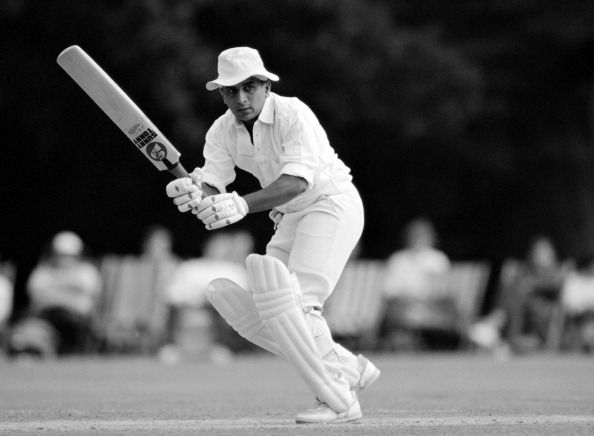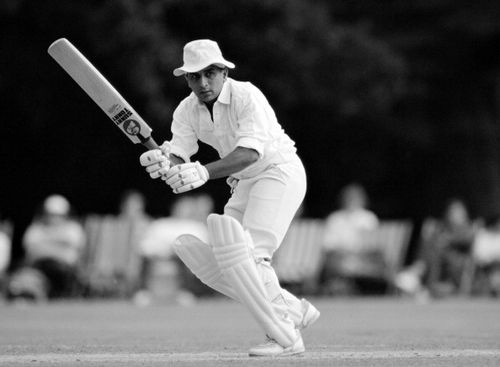
Genius at work, Sunil Gavaskar

Sunil Gavaskar
1948…
A roar followed the dismissal of Sydney Barnes. Seconds after Barnes vanished from the field and went in to the dressing room, a colossal figure came out to play his last innings. Much to the fans’ unbridled delight, the visiting Australians, who were already 3-0 up in the Ashes, didn’t send a nightwatchman to end the day’s play. As the batsman surveyed the scene around him, Norman Yardley, England’s captain, took his cap off as a mark of respect, and his team followed suit. It led to one of the most unforgettable sights that one could see on a cricketing field. A cricket team and an entire ground forgot twenty years of humiliation and subjection to give three cheers to the man who was their greatest cricketing adversary.
1987…
The Indian batsmen were struggling to come to terms with a square turner at the M Chinnaswamy stadium in Bangalore. While Tauseef Ahmed and Iqbal Qasim were wreaking havoc, one man was playing as though it was a featherbed; he was in his own league. Striking it cleanly and meeting each and every ball at the meat of the bat, he simply showed the others why he was a class apart from the rest. The competition between bat and ball was fierce, because it was a match between the archrivals India and Pakistan. Like Bradman in 1948, Sunil Manohar Gavaskar needed a solitary boundary to take his tally up to a hundred. But it is not everyday that someone receives a fairy tale ending. It would have brought up his 35th hundred, six more than the next best at that time.
Gavaskar soon was on 96. Qasim started another over. The ball hit Gavaskar’s knee roll and flew into the hands of a slip fielder who pounced on it. The umpire, VK Ramaswamy, was for once misled due to the rare breach in Gavaskar’s defense. The index finger went up, and Gavaskar made his way back to the pavilion for one last time donning the Indian cap.
For many generations, India has been dominated by the 3 C’s: cinema, congress and cricket. Cinema saw the advent of an angry young man in the mid seventies. Congress saw the might of a lady taking on the might of the erstwhile rulers and the chivalrous men who deemed her ‘unfit’ to be a Prime Minister. And last but not the least, Indian Cricket saw in itself a glimmer of hope; a hope which was kindled due to a man who transformed the way cricket was perceived in the subcontinent nation.
At first, nothing strikes you about the Bhagirathi buildings, located in the area known as Chikalwadi in Southern Mumbai. There are four structures in all, two on each side of an approximately 50-metre long alley that extends from the main entrance of the compound to the garages. But it was here that one of cricket’s glorious success stories began.
Born on July 10, 1949, Sunil Manohar Gavaskar was a part of independent India’s first generation. The mood of the people around him was vibrant, and that set the tone for the first great cricketer from independent India. Yes, there were people like the legendary Mulvantarai ‘Vinoo’ Mankad, Polly Umrigar, MAK Pataudi and the famed quartet of spinners, but their success was nothing like what Gavaskar achieved in his zenith.
For a nation such as ours where success at the international level was once in a blue moon occurence at his time, the arrival of Gavaskar was exactly what was needed to transfrom the game in the country. Many historians have classified Indian cricket as Gavaskar A.D and Gavaskar B.C.
A beginning which was no less Bradmanesque, Gavaskar possibly had the best start to a cricketing career as he notched up 774 runs in his first four Test matches, besides leading India to their first victory in the Caribbean.
That soon made him the poster boy of Indian cricket.
Many a famous personality praised this ‘little wonder’. Ray Robinson, a doyen of Australian cricket writers, did not conceal his compatriots’ curiosity as he openly asked as to when the Australians would see Gavaskar. And he further added that he hoped the answer would not be ‘as long as it would take India, Pakistan, New Zealand and Sri Lanka took to see Don Bradman’. That would another way mean to say ‘never’.